|
|
|
Sort Order |
|
|
|
Items / Page
|
|
|
|
|
|
|
| Srl | Item |
| 1 |
ID:
152958
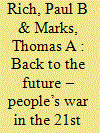

|
|
|
|
|
| Summary/Abstract |
This issue of Small Wars and Insurgencies focuses on the continuing importance of Maoist and post-Maoist concepts of people’s war. It has assembled a collection of papers that addresses various examples from around the world, with an emphasis on South America, where the premier illustration, that of Colombia’s FARC, was Marxist-Leninist but not Maoist, yet embraced the form and strategy of people’s war in a bid which at one point had the state in a critical situation. The collection comes in the wake of previous papers published in this journal on politically Maoist insurgent movements in South Asia, notably Mika Kerttuenen’s study of Maoist insurgents in Nepal and Prem Mahadevan’s survey of Maoist insurgencies in India and their links to organized crime (Kerttunen, “A Transformed Insurgency,” 78–118; Mahadevan, “The Maoist Insurgency in India,” 203–20). The papers confirm that people’s war remains an important analytical framework in the study of small wars and insurgencies, for some even a ‘model’ through which to understand distinct types of insurgent movements and their strategies.
|
|
|
|
|
|
|
|
|
|
|
|
|
|
|
|
| 2 |
ID:
131980
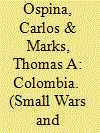

|
|
|
|
|
| Publication |
2014.
|
| Summary/Abstract |
From 1965 to the present, Colombia has been confronted by the insurgency of the Revolutionary Armed Forces of Colombia (FARC). The threat reached a new level in 1996 with the advent of mobile warfare, whereby large units sought to neutralize the military in an effort to seize power and institute a Marxist-Leninist regime. Unlike Vietnam, what followed was a regaining of the strategic initiative by the government and a decimation of the insurgent threat. This was accomplished with US assistance but from first to last was driven by Colombian leadership and strategy. The strategy which led to this signal change, 'Democratic Security', unfolded under the leadership of President Álvaro Uribe. It was a civil-military partnership, which sought to expand the writ of Colombian democracy to all elements of society. Securing the population provided the shield behind which economic, social, and political life could occur as driven by the will of the people. It was the agreement upon legitimacy as the strategic goal and reform as the route to that goal which allowed the Colombians and the Americans to work so well together.
|
|
|
|
|
|
|
|
|
|
|
|
|
|
|
|
| 3 |
ID:
069051


|
|
|
| 4 |
ID:
193168
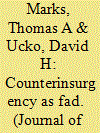

|
|
|
|
|
| Summary/Abstract |
The counterinsurgency era that dominated American military discussion post-9/11 has passed. The desire to move on, particularly since the loss of Afghanistan in August 2021, has left unsettled a conversation on counterinsurgency that, both among supporters and detractors, was often dangerously narrow. Too hastily embraced and too rapidly abandoned, counterinsurgency generated false promises and then became the scapegoat for poor strategy. This article examines the counterinsurgency era that was and demonstrates how fad-like engagement with the topic in both military and academic circles subverted the supposed learning process taking place. It argues that the lessons from this engagement are mostly misleading or at least incomplete, but it also notes that there is minimal appetite to look deeper into a topic now deemed toxic. Therein lies significant danger.
|
|
|
|
|
|
|
|
|
|
|
|
|
|
|
|
| 5 |
ID:
152961
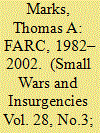

|
|
|
|
|
| Summary/Abstract |
Recent controversy during the conclusion of peace talks has renewed discussion as to the nature of the effort by Fuerzas Armadas Revolucionarias de Colombia, or FARC (Revolutionary Armed Forces of Colombia), to seize state power. FARC presents itself as an insurgency produced by societal imperfections and purports to speak for the marginalized and alienated of Colombia. Critics contend that FARC is a ruthless narcoterrorist organization that has targeted the people. In fact, FARC comes closer to the latter than the former, because its critical decision to privilege criminality for generation of means destroyed execution of a viable people’s war strategy. Ultimately, means devoured ways in such manner as to make ends unachievable. Criminality, though it made FARC perhaps the richest insurgent group in the world during its heyday, laid the foundation for its defeat by ceding legitimacy, and thus mass mobilization, to the democratic state.
|
|
|
|
|
|
|
|
|
|
|
|
|
|
|
|
| 6 |
ID:
178551
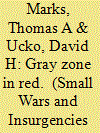

|
|
|
|
|
| Summary/Abstract |
With the United States having shifted its defense emphasis to peer and near-peer rivals, study of irregular warfare has likewise expanded its scope to applicable lessons for the strategic level, within the context of great-power competition. In theory, meanwhile, concern for sub-state actors remains an integral mission for the Department of Defense (DoD), with formal tasking issued to integrate into joint professional military education (JPME) the insights drawn from the last two decades of commitment. The resulting synthesis has led to a discussion of what has variously been termed gray zone conflict, hybrid war, or political warfare.
|
|
|
|
|
|
|
|
|
|
|
|
|
|
|
|
| 7 |
ID:
051999


|
|
|
| 8 |
ID:
168265


|
|
|
| 9 |
ID:
048787
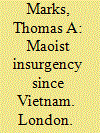

|
|
|
|
|
| Publication |
London, Frank Cass, 1996.
|
| Description |
303p.
|
| Standard Number |
0714641235
|
|
|
|
|
|
|
|
|
|
|
|
Copies: C:1/I:0,R:0,Q:0
Circulation
| Accession# | Call# | Current Location | Status | Policy | Location |
| 039050 | 355.0218/MAR 039050 | Main | On Shelf | General | |
|
|
|
|
| 10 |
ID:
165181


|
|
|
| 11 |
ID:
067047


|
|
|
| 12 |
ID:
131986
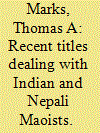

|
|
|
|
|
| Publication |
2014.
|
| Summary/Abstract |
A joint publication of the International Work Group for Indigenous Affairs (IWGIA) and Bindrai Institute for Research Study and Action (BIRSA), this treatment reads as a cross between a Zapatista manifesto and useful scholarship. It is worth quoting in full the cover blurb, because it illustrates well an approach which emerges in perhaps a majority of the works on Indian Maoism: 'The basic line of inquiry concerning the issues (dispossession from life supporting resources of land, forest, water and identity), the main cause (internal colonialism) and the remedy (provision of autonomy), has been discussed by leading social scientists and activists. In the process can be seen emerging a development critique with an alternative provided by the tribal/indegeous [sic] perspective aimed at reconstructing a society based on equality; economy based on cooperation, caring-sharing conservation, subsistence and decentralization; a policy based on conscience democracy [sic] and art based on collective participation and enjoyment.
|
|
|
|
|
|
|
|
|
|
|
|
|
|
|
|
| 13 |
ID:
152018
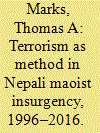

|
|
|
|
|
| Summary/Abstract |
During the period 1996–2006, the Communist Party of Nepal (Maoist) waged overt people’s war to seize state power and institute a new order that realized the party’s understanding of ‘New Democracy’ as posited by Mao Tse-tung. Contextual shifts led to a crucial strategic turning point in September 2005, when the Maoists agreed to a united front with estranged legal parties to oust the monarchy and establish a republic. Though touted as acceptance of political reintegration, the move was tactical rather than strategic. The party had no intention of supporting a parliamentary version of democracy and thus, 2006–2016, engaged in a covert effort to seize power. Central to this effort was the paramilitary Young Communist League (YCL), the members of which responded to inflammatory party verbiage and exhortations with attacks upon rival political actors. These attacks, academically and legally, were terrorism and offered a salient illustration of intra-state unrestricted warfare. Ultimately, organizational, national, and regional circumstances caused the main Maoist movement to move decisively away from its covert approach. By that time, however, radical splinters had embraced the use of terrorism against rival political actors, creating a situation whereby local politics is yet a dangerous endeavor in certain areas and at certain times.
|
|
|
|
|
|
|
|
|
|
|
|
|
|
|
|
| 14 |
ID:
051932


|
|
|
| 15 |
ID:
159148
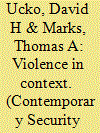

|
|
|
|
|
| Summary/Abstract |
The malaise that the United States, and the West, have experienced in recent campaigns stems in large part from unclear thinking about war, its political essence, and the strategies needed to join the two. Instead, analysis and response are predicated on entrenched theoretical concepts with limited practical utility. The inadequacy of understanding has spawned new, and not so new, terms to capture unanticipated trends, starting with the re-discovery of “insurgency” and “counterinsurgency” and leading to discussion of “hybrid threats” and “gray-zone” operations. New terminology can help, but the change must go deeper. Challenging analytical orthodoxy, this article sets out a unifying approach for the study of political violence, or more accurately: violent politics. It provides a conceptual foundation that helps to make sense of recent shifts in warfare. In effect, it offers sorely needed theoretical insights into the nature of strategy and guides the process of responding to nontraditional threats.
|
|
|
|
|
|
|
|
|
|
|
|
|
|
|
|
|
|
|
|
|